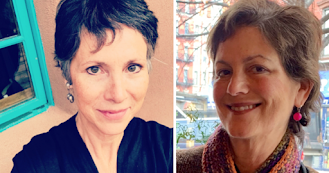From the Rubin Foundation press release: “The title of the exhibition alludes to the late artist Robert Smithson’s essay “A Sedimentation of the Mind: Earth Projects,” in which he associates the shifting of the earth with flows of thought, positing that the “mind and earth are both in a constant state of erosion…ideas decompose into stones of unknowing, and conceptual crystallizations break apart into deposits of gritty reason.” The featured artists employ strategies of reuse in their art making, incorporating found and repurposed materials, from accumulation and assemblage to the construction of landscapes and discrete objects. The works reference a multitude of timescales and politics. - Sara Reisman
Included in the exhibition is MierleLaderman Ukeles, NYC Sanitation Department Artist in Residence since 1976. The original plan was to interview Ukeles during the exhibition since ecoartspace has been in a conversation
with Mierle to include her in our video archive. However, she was unable to attend, so Lipton decided to focus on Ukeles' work in her interview with Mary Mattingly and Jean shin instead. Together they discussed Ukeles art-as-maintenance manifesto
and in particular her 1979 performance work “Touch Sanitation,” and
her 1983 work “Social Mirror." Lipton also focused the discussion on the viability of such projects that require long term maintenance (site workers, ongoing care, repair, etc.). She asked Mattingly
and Shin if maintenance issues also applied to their own work. The answer was a resounding yes. Both artists are based in New York City
and have done substantial long-term public art projects, so the lineage from
Mierle Ukeles practice is present and influential.
Mary Mattingly founded a floating food forest on a barge in New York
called Swale. Lipton had the opportunity to visit Mary aboard Swale before it’s
completion in 2016 in Verplanck NY. Now floating on New York’s waterways, this important project
is considered a community resource artwork. The barge is 130-by-40-foot and contains a
forest garden of edible and medicinal plants, including blackberries,
blueberries, strawberries, dandelions, stinging nettle, comfrey, chamomile and
more. Filtered rainwater and water from New York’s rivers hydrate the plants.
Visitors are welcome to come and pick items for free, and are also encouraged to
bring food items of their own. It’s illegal to grow public food in public
spaces in New York City, so Mattingly keenly moved her project to the water.
Jean Shin makes
site-specific installations that transform everyday objects into elegant
expressions of identity and community engagement. Her work is distinguished by
a labor-intensive process and immersive environments that
reflect collective issues that we face as a society. As an accomplished
artist practicing in the public realm, she also realizes large-scale,
site-specific permanent installations commissioned by major public agencies on
the federal level (US General Services Administration) as well as local city and
arts for transit programs (New York City’s Metropolitan Transit Authority and
Percent for the Art programs, etc.). Shin recently completed a landmark
commission for New York City MTA’s Second Avenue Subway at the 63rd Street
station.
Below are
some of the questions Lipton asked Mattingly and Shin during their live interview:
Thinking about the title Sedimentations, my
thoughts are about geologic time and the larger picture regarding our eco
system and its potential healing. How do you think about sedimentations?
How do you see your work in regards to the
exhibition title of “social repair”? Is working with community an important
part of social repair for each of you?
Regarding issues of re-use and waste in your
artwork, -what really is waste when it comes to food, as opposed to mining and
resource extraction?
How working collaboratively with community
transforms waste from commodities into art and consciousness raising?
A video recording
of this interview will soon be available as part of the ongoing ecoartspace
interview archive. See HERE
 |
| From Left to Right: Jean Shin, Amy Lipton, Mary Mattingly and Sara Reisman |









